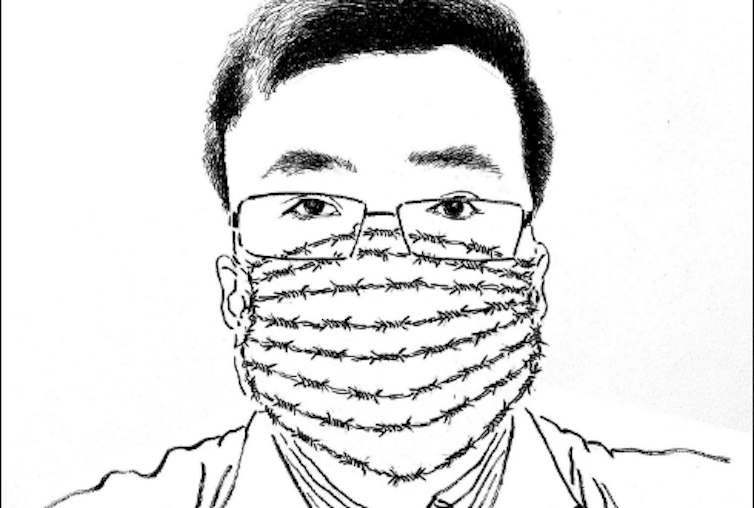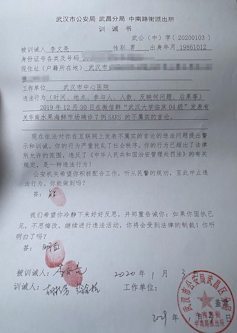China’s coronavirus cover-up: how censorship and propaganda obstructed the truth

Kuang Biao, CC BY-SA
Courtesy of Paul Gardner, University of Glasgow
China’s political leaders will be hoping that when concerns about the coronavirus eventually start to recede, memories about the state’s failings early on in the outbreak will also fade. They will be particularly keen for people to forget the anger many felt after the death from Covid-19 of Dr Li Wenliang, the doctor censured for trying to warn colleagues about the outbreak. After Dr Li’s death, the phrase “We want freedom of speech” was even trending on Chinese social media for several hours before the posts were deleted.
Dr Li had told fellow medical professionals about the new virus in a chat group on 30 December. He was accused of “rumour-mongering” and officials either ignored or played down the risks well into January. “If officials had disclosed information about the epidemic earlier,” Dr Li told the New York Times, “I think it would have been a lot better. There should be more openness and transparency”.
I am currently researching the Chinese party-state’s efforts to increase legitimacy by controlling the information that reaches its citizens. The lack of openness and transparency in this crucial early phase of the outbreak was partly because officials were gathering for annual meetings of the local Communist Party-run legislatures, when propaganda departments instruct the media not to cover negative stories.
However, the censorship in this period also reflects increasingly tight control over information in China. As Chinese media expert Anne-Marie Brady notes, from the beginning of his presidency, Xi Jinping was clear the media should “focus on positive news stories that uphold unity and stability and are encouraging”.
Curtailing media freedoms
The deterioration in the media’s limited freedoms under Xi Jinping was underlined by a visit he made to media organisations in 2016, declaring that, “All Party media have the surname Party”, and demanding loyalty to the Chinese Communist Party (CCP).
There have been a series of good quality investigative reports, notably by the business publication Caixin, since the authorities fully acknowledged the virus. As political scientist Maria Repnikova argues, providing temporary space for the media to report more freely can help the party-state “project an image of managed transparency”. However, the clampdown has undoubtedly had a significant effect on the media’s ability to provide effective investigative reporting, particularly early on in the outbreak.

Dr Li’s coronavirus admonishment notice served on 3 January 2020. A month later he was dead from Covid-19. Author provided
Online, there have been a succession of measures to limit speech the party deems a threat. These include laws that mean the threat of jail for anyone found guilty of spreading “rumours”. In an authoritarian regime, stopping rumours limits people’s ability to raise concerns and potentially discover the truth. A point made only too clearly by Dr Li’s case.
The party focuses its censorship on problems that might undermine its legitimacy. Part of my ongoing research into information control in China involves an analysis of leaked censorship instructions collected by the US-based China Digital Times. This shows that between 2013 and 2018, over 100 leaked instructions concerned problems about the environment, food safety, health, education, natural disasters and major accidents. The actual number is likely to far exceed this.
For example, after an explosion at a petrochemical factory, media organisations were told to censor “negative commentary related to petrochemical projects”. And after parents protested about tainted vaccines, the media were instructed that only information provided by official sources could be used on front pages.
State media play a key role in the CCP’s efforts to set the agenda online. My research shows that the number of stories featuring problems about the environment and disasters posted by People’s Daily newspaper on Sina Weibo (China’s equivalent of Twitter) fell significantly between 2013 and 2018.
Around 4.5% of all People Daily’s Weibo posts between 2013 and 2015 were about the environment, but by 2018 had fallen to as low as 1%. Similarly, around 8%-10% of all posts by the newspaper were about disasters and major accidents between 2013 and 2015, but this figure fell to below 4% in the following three years.
The party wants people to focus instead on topics it thinks will enhance its legitimacy. The number of posts by People’s Daily focusing on nationalism had doubled to 12% of the total by 2018.
Citizen journalism fights back
As well as investigative reports on the outbreak in parts of the media, some Chinese individuals have also gone to great lengths to communicate information about the virus and conditions in Wuhan. However, the authorities have been steadily silencing significant critical voices and stepping up their efforts to censor other content they deem particularly unhelpful.
The censors do not stop everything, but as the China scholar Margaret E. Roberts suggests, “porous censorship” can still be very effective. She points out that the Chinese authorities’ efforts to make it more difficult for people to access critical content that does make it online, while flooding the internet with information the CCP wants them to see, can still be very effective.
When a problem cannot be avoided, my research shows that the propaganda authorities try to control the narrative by ensuring the media focus on the state’s efforts to tackle the problem. After a landslide at a mine in Tibet, the media were told to “cover disaster relief promptly and abundantly”. Coverage of such disasters by People’s Daily focuses on images of heroic rescue workers.
This same propaganda effort is in evidence now. As the China Media Project’s David Bandurski notes, media coverage in China is increasingly seeking to portray the Chinese Communist Party “as the enabler of miraculous human feats” battling the virus.
After Dr Li’s death, CCP leaders sought to blame local officials for admonishing him. However, the actions taken against Dr Li were fully consistent with the Party’s approach to controlling information under Xi Jinping.
It is impossible to know how many people have died, or might die in future, because people have decided to self-censor, rather than risk punishment for spreading rumours, or because the authorities have sought to avoid information reaching the public. The coronavirus outbreak highlights the risks of a system that puts social stability and ruling party legitimacy above the public interest.
Paul Gardner, PhD Candidate in Chinese Studies and Political Communication, University of Glasgow
![]()
This article is republished from The Conversation under a Creative Commons license. Read the original article.



